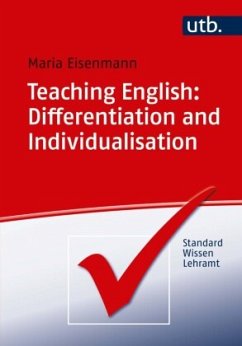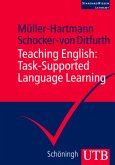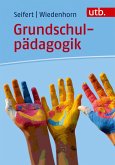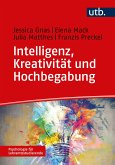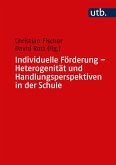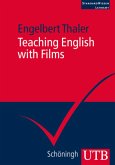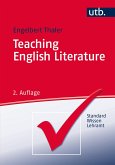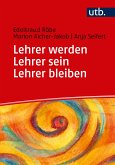Maria Eisenmann
Teaching English: Differentiation and Individualisation
10,99 €
inkl. MwSt.
Versandfertig in 2-4 Wochen
Maria Eisenmann
Teaching English: Differentiation and Individualisation
- Broschiertes Buch
- Merkliste
- Auf die Merkliste
- Bewerten Bewerten
- Teilen
- Produkt teilen
- Produkterinnerung
- Produkterinnerung
Heterogenität im Klassenzimmer ist Alltag und eine Herausforderung. Auch Englischlehrkräfte sind aufgefordert, dies mit speziell zugeschnittenen Lernarrangements zu berücksichtigen. Maria Eisenmann führt daher nicht nur in die Theorien von Heterogenität, Differenzierung und Inklusion ein, sondern stellt individualisierende Methoden und Lernstrategien für die Praxis des Unterrichts vor.
Andere Kunden interessierten sich auch für
![Teaching English: Task-Supported Language Learning Teaching English: Task-Supported Language Learning]() Andreas Müller-HartmannTeaching English: Task-Supported Language Learning10,99 €
Andreas Müller-HartmannTeaching English: Task-Supported Language Learning10,99 €![Grundschulpädagogik Grundschulpädagogik]() Anja SeifertGrundschulpädagogik24,99 €
Anja SeifertGrundschulpädagogik24,99 €![Intelligenz, Kreativität und Hochbegabung Intelligenz, Kreativität und Hochbegabung]() Jessica GnasIntelligenz, Kreativität und Hochbegabung20,00 €
Jessica GnasIntelligenz, Kreativität und Hochbegabung20,00 €![Individuelle Förderung - Heterogenität und Handlungsperspektiven in der Schule Individuelle Förderung - Heterogenität und Handlungsperspektiven in der Schule]() Individuelle Förderung - Heterogenität und Handlungsperspektiven in der Schule29,90 €
Individuelle Förderung - Heterogenität und Handlungsperspektiven in der Schule29,90 €![Teaching English with Films Teaching English with Films]() Engelbert ThalerTeaching English with Films10,99 €
Engelbert ThalerTeaching English with Films10,99 €![Teaching English Literature Teaching English Literature]() Engelbert ThalerTeaching English Literature19,99 €
Engelbert ThalerTeaching English Literature19,99 €![Lehrer werden - Lehrer sein - Lehrer bleiben Lehrer werden - Lehrer sein - Lehrer bleiben]() Edeltraud RöbeLehrer werden - Lehrer sein - Lehrer bleiben24,99 €
Edeltraud RöbeLehrer werden - Lehrer sein - Lehrer bleiben24,99 €-
-
-
Heterogenität im Klassenzimmer ist Alltag und eine Herausforderung. Auch Englischlehrkräfte sind aufgefordert, dies mit speziell zugeschnittenen Lernarrangements zu berücksichtigen. Maria Eisenmann führt daher nicht nur in die Theorien von Heterogenität, Differenzierung und Inklusion ein, sondern stellt individualisierende Methoden und Lernstrategien für die Praxis des Unterrichts vor.
Hinweis: Dieser Artikel kann nur an eine deutsche Lieferadresse ausgeliefert werden.
Hinweis: Dieser Artikel kann nur an eine deutsche Lieferadresse ausgeliefert werden.
Produktdetails
- Produktdetails
- UTB Uni-Taschenbücher 5109
- Verlag: Brill Schöningh / UTB
- Artikelnr. des Verlages: 5109
- Seitenzahl: 245
- Erscheinungstermin: 14. Mai 2019
- Englisch
- Abmessung: 253mm x 152mm x 15mm
- Gewicht: 378g
- ISBN-13: 9783825251093
- ISBN-10: 3825251098
- Artikelnr.: 54555743
- UTB Uni-Taschenbücher 5109
- Verlag: Brill Schöningh / UTB
- Artikelnr. des Verlages: 5109
- Seitenzahl: 245
- Erscheinungstermin: 14. Mai 2019
- Englisch
- Abmessung: 253mm x 152mm x 15mm
- Gewicht: 378g
- ISBN-13: 9783825251093
- ISBN-10: 3825251098
- Artikelnr.: 54555743
Introduction1 STATUS QUO1.1 The Development of Educational Standards in EFL Teaching201.2 A Critical View on Competencies in Language Learning and Teaching252 HETEROGENEITY IN THE EFL CLASSROOM2.1 The Myth of the Homogeneous Learner Group282.2 Heterogeneity and Diversity as a Chance for EFL Teaching292.3 Educational Standards Versus Individualised Instruction?303 LEARNER TYPES AND LEARNING STRATEGIES3.1 Interindividual and Intraindividual Differences363.2 Theoretical Concepts of Individual Learner Differences373.2.1 The Learner Types According to Skehan and Ellis373.2.2 The Learner Types According to Vester383.2.3 The Learner Types According to Nunan403.2.4 Gardner's Theory of Multiple Intelligences413.3 Students' Diversity443.4 Diagnoses473.5 Bloom's Taxonomy483.6 Learning Styles and Learning Strategies504 DIFFERENTIATION AND INDIVIDUALISATION - A DEFINITION4.1 External and Internal Differentiation564.2 Individualisation and Adaptive Teaching584.3 Possible Fields of Differentiation614.4 Challenges and Pitfalls634.5 Key Principles of Differentiated EFL Teaching6567 4.5.1 Variety of Methods4.5.2 Holistic Approach684.5.3 Open Forms of Teaching and Learning694.5.4 Cooperative Learning704.5.5 Variety of Materials and Media715 METHODS OF DIFFERENTIATION AND INDIVIDUALISATION5.1 General Differentiating Teaching Concepts and Principles745.1.1 Independent Study745.1.2 Weekly Plan765.1.3 Learning at Workstations775.1.4 Project-based Language Learning805.1.5 Task-based Language Learning825.1.6 Extensive Reading875.1.7 Keeping a Reading Log885.2 Further Cooperative Individualising Teaching and Learning Scenarios915.2.1 Learning Through Teaching915.2.2 Think-Pair-Share925.2.3 Jigsaw Puzzle945.2.4 Bus Stop965.2.5 Placemat975.2.6 Gallery Walk975.2.7 Four Corners995.2.8 Numbered Heads Together1015.2.9 Reciprocal Teaching1025.2.10 Reading Circles1035.3 Requirements for Successful Cooperative Learning1055.3.1 Learners' Willingness1065.3.2 Group Formation1065.3.3 Task Design1075.4 Games for Differentiation and Individualisation1085.4.1 Benefits of Playing Games in the EFL Classroom1085.4.2 Games as a Differentiating Concept for EFL Teaching1095.4.3 Types of Games1106 DIFFERENTIATION AND INDIVIDUALISATION THROUGH DIGITAL MEDIA6.1 E-learning and Blended Learning1146.2 Web 1.0, 2.0, 3.0 - Timeline and Definition1156.3 How Web 2.0 Tools Foster Individualised Instruction1166.4 Examples of Practice1196.4.1 Digital Media for Communication1196.4.2 Webquest1216.4.3 Wiki1236.4.4 Podcasts and Vodcasts1246.4.5 Weblog/Videoblog1276.4.6 Social Media1306.4.7 Edu-Apps and Mobile Learning1336.4.8 Gamification1366.4.9 Virtual Reality1396.4.10 Augmented Reality1417 DIFFERENTIATING FORMS OF ASSESSMENT AND EVALUATION7.1 Language Assessment Literacy1447.2 Testing, Assessment, Evaluation1467.3 Washback1467.4 Quality Criteria of Assessment1477.5 Purposes of Assessment1497.6 Diagnostic Assessment1497.7 Alternative Assessment1507.8 One Tool Does Not Fit all - Differentiated Assessment Strategies1527.8.1 Creating a Portfolio Assignment1527.8.2 E-portfolio Assignment1627.8.3 Learning Contracts1637.8.4 Self and Peer Assessment1667.8.5 Learning Process Observation1697.8.6 Feedback on Oral Production1717.8.7 Digital Assessment1758 STUDENT AND TEACHER ROLES IN A DIFFERENTIATED EFL CLASSROOM8.1 Redefined Roles for Students and Teachers1808.2 Teacher as a Reflective Practitioner and Action Researcher1848.3 The Flipped Classroom1879 AUTONOMOUS LANGUAGE LEARNING AS AN OPPORTUNITY FOR DIFFERENTIATION AND INDIVIDUALISATION9.1 The Concept of Learner Autonomy1949.2 Individualisation and Learner Autonomy1979.3 Effectiveness of Autonomous Learning1979.4 A Model for Developing Learner Autonomy19810 FUTURE PERSPECTIVES: THE CHALLENGE OF INCLUSIVE EDUCATION10.1 The UN-Convention on the Rights of Persons wi
Introduction 1 STATUS QUO 1.1 The Development of Educational Standards in EFL Teaching20 1.2 A Critical View on Competencies in Language Learning and Teaching25 2 HETEROGENEITY IN THE EFL CLASSROOM 2.1 The Myth of the Homogeneous Learner Group28 2.2 Heterogeneity and Diversity as a Chance for EFL Teaching29 2.3 Educational Standards Versus Individualised Instruction?30 3 LEARNER TYPES AND LEARNING STRATEGIES 3.1 Interindividual and Intraindividual Differences36 3.2 Theoretical Concepts of Individual Learner Differences37 3.2.1 The Learner Types According to Skehan and Ellis37 3.2.2 The Learner Types According to Vester38 3.2.3 The Learner Types According to Nunan40 3.2.4 Gardner’s Theory of Multiple Intelligences41 3.3 Students’ Diversity44 3.4 Diagnoses47 3.5 Bloom’s Taxonomy48 3.6 Learning Styles and Learning Strategies50 4 DIFFERENTIATION AND INDIVIDUALISATION – A DEFINITION 4.1 External and Internal Differentiation56 4.2 Individualisation and Adaptive Teaching58 4.3 Possible Fields of Differentiation61 4.4 Challenges and Pitfalls63 4.5 Key Principles of Differentiated EFL Teaching65 67 4.5.1 Variety of Methods 4.5.2 Holistic Approach68 4.5.3 Open Forms of Teaching and Learning69 4.5.4 Cooperative Learning70 4.5.5 Variety of Materials and Media71 5 METHODS OF DIFFERENTIATION AND INDIVIDUALISATION 5.1 General Differentiating Teaching Concepts and Principles74 5.1.1 Independent Study74 5.1.2 Weekly Plan76 5.1.3 Learning at Workstations77 5.1.4 Project-based Language Learning80 5.1.5 Task-based Language Learning82 5.1.6 Extensive Reading87 5.1.7 Keeping a Reading Log88 5.2 Further Cooperative Individualising Teaching and Learning Scenarios91 5.2.1 Learning Through Teaching91 5.2.2 Think-Pair-Share92 5.2.3 Jigsaw Puzzle94 5.2.4 Bus Stop96 5.2.5 Placemat97 5.2.6 Gallery Walk97 5.2.7 Four Corners99 5.2.8 Numbered Heads Together101 5.2.9 Reciprocal Teaching102 5.2.10 Reading Circles103 5.3 Requirements for Successful Cooperative Learning105 5.3.1 Learners’ Willingness106 5.3.2 Group Formation106 5.3.3 Task Design107 5.4 Games for Differentiation and Individualisation108 5.4.1 Benefits of Playing Games in the EFL Classroom108 5.4.2 Games as a Differentiating Concept for EFL Teaching109 5.4.3 Types of Games110 6 DIFFERENTIATION AND INDIVIDUALISATION THROUGH DIGITAL MEDIA 6.1 E-learning and Blended Learning114 6.2 Web 1.0, 2.0, 3.0 – Timeline and Definition115 6.3 How Web 2.0 Tools Foster Individualised Instruction116 6.4 Examples of Practice119 6.4.1 Digital Media for Communication119 6.4.2 Webquest121 6.4.3 Wiki123 6.4.4 Podcasts and Vodcasts124 6.4.5 Weblog/Videoblog127 6.4.6 Social Media130 6.4.7 Edu-Apps and Mobile Learning133 6.4.8 Gamification136 6.4.9 Virtual Reality139 6.4.10 Augmented Reality141 7 DIFFERENTIATING FORMS OF ASSESSMENT AND EVALUATION 7.1 Language Assessment Literacy144 7.2 Testing, Assessment, Evaluation146 7.3 Washback146 7.4 Quality Criteria of Assessment147 7.5 Purposes of Assessment149 7.6 Diagnostic Assessment149 7.7 Alternative Assessment150 7.8 One Tool Does Not Fit all – Differentiated Assessment Strategies152 7.8.1 Creating a Portfolio Assignment152 7.8.2 E-portfolio Assignment162 7.8.3 Learning Contracts163 7.8.4 Self and Peer Assessment166 7.8.5 Learning Process Observation169 7.8.6 Feedback on Oral Production171 7.8.7 Digital Assessment175 8 STUDENT AND TEACHER ROLES IN A DIFFERENTIATED EFL CLASSROOM 8.1 Redefined Roles for Students and Teachers180 8.2 Teacher as a Reflective Practitioner and Action Researcher184 8.3 The Flipped Classroom187 9 AUTONOMOUS LANGUAGE LEARNING AS AN OPPORTUNITY FOR DIFFERENTIATION AND INDIVIDUALISATION 9.1 The Concept of Learner Autonomy194 9.2 Individualisation and Learner Autonomy197 9.3 Effectiveness of Autonomous Learning197 9.4 A Model for Developing Learner Autonomy198 10 FUTURE PERSPECTIVES: THE CHALLENGE OF INCLUSIVE EDUCATION 10.1 The UN-Convention on the Rights of Persons with Disabilities204 10.2 From Exclusion to Inclusion206 10.2.1 Exclusion206 10.2.2 Segregation207 10.2.3 Integration208 10.2.4 Inclusion208 10.3 Index of Inclusion209 10.4 The Implementation of Inclusion in the EFL Classroom210 10.5 Benefits and Drawbacks of Inclusive Education in EFL Teaching212 Suggested Answers for the Tasks217 Bibliography229 Index241
Introduction1 STATUS QUO1.1 The Development of Educational Standards in EFL Teaching201.2 A Critical View on Competencies in Language Learning and Teaching252 HETEROGENEITY IN THE EFL CLASSROOM2.1 The Myth of the Homogeneous Learner Group282.2 Heterogeneity and Diversity as a Chance for EFL Teaching292.3 Educational Standards Versus Individualised Instruction?303 LEARNER TYPES AND LEARNING STRATEGIES3.1 Interindividual and Intraindividual Differences363.2 Theoretical Concepts of Individual Learner Differences373.2.1 The Learner Types According to Skehan and Ellis373.2.2 The Learner Types According to Vester383.2.3 The Learner Types According to Nunan403.2.4 Gardner's Theory of Multiple Intelligences413.3 Students' Diversity443.4 Diagnoses473.5 Bloom's Taxonomy483.6 Learning Styles and Learning Strategies504 DIFFERENTIATION AND INDIVIDUALISATION - A DEFINITION4.1 External and Internal Differentiation564.2 Individualisation and Adaptive Teaching584.3 Possible Fields of Differentiation614.4 Challenges and Pitfalls634.5 Key Principles of Differentiated EFL Teaching6567 4.5.1 Variety of Methods4.5.2 Holistic Approach684.5.3 Open Forms of Teaching and Learning694.5.4 Cooperative Learning704.5.5 Variety of Materials and Media715 METHODS OF DIFFERENTIATION AND INDIVIDUALISATION5.1 General Differentiating Teaching Concepts and Principles745.1.1 Independent Study745.1.2 Weekly Plan765.1.3 Learning at Workstations775.1.4 Project-based Language Learning805.1.5 Task-based Language Learning825.1.6 Extensive Reading875.1.7 Keeping a Reading Log885.2 Further Cooperative Individualising Teaching and Learning Scenarios915.2.1 Learning Through Teaching915.2.2 Think-Pair-Share925.2.3 Jigsaw Puzzle945.2.4 Bus Stop965.2.5 Placemat975.2.6 Gallery Walk975.2.7 Four Corners995.2.8 Numbered Heads Together1015.2.9 Reciprocal Teaching1025.2.10 Reading Circles1035.3 Requirements for Successful Cooperative Learning1055.3.1 Learners' Willingness1065.3.2 Group Formation1065.3.3 Task Design1075.4 Games for Differentiation and Individualisation1085.4.1 Benefits of Playing Games in the EFL Classroom1085.4.2 Games as a Differentiating Concept for EFL Teaching1095.4.3 Types of Games1106 DIFFERENTIATION AND INDIVIDUALISATION THROUGH DIGITAL MEDIA6.1 E-learning and Blended Learning1146.2 Web 1.0, 2.0, 3.0 - Timeline and Definition1156.3 How Web 2.0 Tools Foster Individualised Instruction1166.4 Examples of Practice1196.4.1 Digital Media for Communication1196.4.2 Webquest1216.4.3 Wiki1236.4.4 Podcasts and Vodcasts1246.4.5 Weblog/Videoblog1276.4.6 Social Media1306.4.7 Edu-Apps and Mobile Learning1336.4.8 Gamification1366.4.9 Virtual Reality1396.4.10 Augmented Reality1417 DIFFERENTIATING FORMS OF ASSESSMENT AND EVALUATION7.1 Language Assessment Literacy1447.2 Testing, Assessment, Evaluation1467.3 Washback1467.4 Quality Criteria of Assessment1477.5 Purposes of Assessment1497.6 Diagnostic Assessment1497.7 Alternative Assessment1507.8 One Tool Does Not Fit all - Differentiated Assessment Strategies1527.8.1 Creating a Portfolio Assignment1527.8.2 E-portfolio Assignment1627.8.3 Learning Contracts1637.8.4 Self and Peer Assessment1667.8.5 Learning Process Observation1697.8.6 Feedback on Oral Production1717.8.7 Digital Assessment1758 STUDENT AND TEACHER ROLES IN A DIFFERENTIATED EFL CLASSROOM8.1 Redefined Roles for Students and Teachers1808.2 Teacher as a Reflective Practitioner and Action Researcher1848.3 The Flipped Classroom1879 AUTONOMOUS LANGUAGE LEARNING AS AN OPPORTUNITY FOR DIFFERENTIATION AND INDIVIDUALISATION9.1 The Concept of Learner Autonomy1949.2 Individualisation and Learner Autonomy1979.3 Effectiveness of Autonomous Learning1979.4 A Model for Developing Learner Autonomy19810 FUTURE PERSPECTIVES: THE CHALLENGE OF INCLUSIVE EDUCATION10.1 The UN-Convention on the Rights of Persons wi
Introduction 1 STATUS QUO 1.1 The Development of Educational Standards in EFL Teaching20 1.2 A Critical View on Competencies in Language Learning and Teaching25 2 HETEROGENEITY IN THE EFL CLASSROOM 2.1 The Myth of the Homogeneous Learner Group28 2.2 Heterogeneity and Diversity as a Chance for EFL Teaching29 2.3 Educational Standards Versus Individualised Instruction?30 3 LEARNER TYPES AND LEARNING STRATEGIES 3.1 Interindividual and Intraindividual Differences36 3.2 Theoretical Concepts of Individual Learner Differences37 3.2.1 The Learner Types According to Skehan and Ellis37 3.2.2 The Learner Types According to Vester38 3.2.3 The Learner Types According to Nunan40 3.2.4 Gardner’s Theory of Multiple Intelligences41 3.3 Students’ Diversity44 3.4 Diagnoses47 3.5 Bloom’s Taxonomy48 3.6 Learning Styles and Learning Strategies50 4 DIFFERENTIATION AND INDIVIDUALISATION – A DEFINITION 4.1 External and Internal Differentiation56 4.2 Individualisation and Adaptive Teaching58 4.3 Possible Fields of Differentiation61 4.4 Challenges and Pitfalls63 4.5 Key Principles of Differentiated EFL Teaching65 67 4.5.1 Variety of Methods 4.5.2 Holistic Approach68 4.5.3 Open Forms of Teaching and Learning69 4.5.4 Cooperative Learning70 4.5.5 Variety of Materials and Media71 5 METHODS OF DIFFERENTIATION AND INDIVIDUALISATION 5.1 General Differentiating Teaching Concepts and Principles74 5.1.1 Independent Study74 5.1.2 Weekly Plan76 5.1.3 Learning at Workstations77 5.1.4 Project-based Language Learning80 5.1.5 Task-based Language Learning82 5.1.6 Extensive Reading87 5.1.7 Keeping a Reading Log88 5.2 Further Cooperative Individualising Teaching and Learning Scenarios91 5.2.1 Learning Through Teaching91 5.2.2 Think-Pair-Share92 5.2.3 Jigsaw Puzzle94 5.2.4 Bus Stop96 5.2.5 Placemat97 5.2.6 Gallery Walk97 5.2.7 Four Corners99 5.2.8 Numbered Heads Together101 5.2.9 Reciprocal Teaching102 5.2.10 Reading Circles103 5.3 Requirements for Successful Cooperative Learning105 5.3.1 Learners’ Willingness106 5.3.2 Group Formation106 5.3.3 Task Design107 5.4 Games for Differentiation and Individualisation108 5.4.1 Benefits of Playing Games in the EFL Classroom108 5.4.2 Games as a Differentiating Concept for EFL Teaching109 5.4.3 Types of Games110 6 DIFFERENTIATION AND INDIVIDUALISATION THROUGH DIGITAL MEDIA 6.1 E-learning and Blended Learning114 6.2 Web 1.0, 2.0, 3.0 – Timeline and Definition115 6.3 How Web 2.0 Tools Foster Individualised Instruction116 6.4 Examples of Practice119 6.4.1 Digital Media for Communication119 6.4.2 Webquest121 6.4.3 Wiki123 6.4.4 Podcasts and Vodcasts124 6.4.5 Weblog/Videoblog127 6.4.6 Social Media130 6.4.7 Edu-Apps and Mobile Learning133 6.4.8 Gamification136 6.4.9 Virtual Reality139 6.4.10 Augmented Reality141 7 DIFFERENTIATING FORMS OF ASSESSMENT AND EVALUATION 7.1 Language Assessment Literacy144 7.2 Testing, Assessment, Evaluation146 7.3 Washback146 7.4 Quality Criteria of Assessment147 7.5 Purposes of Assessment149 7.6 Diagnostic Assessment149 7.7 Alternative Assessment150 7.8 One Tool Does Not Fit all – Differentiated Assessment Strategies152 7.8.1 Creating a Portfolio Assignment152 7.8.2 E-portfolio Assignment162 7.8.3 Learning Contracts163 7.8.4 Self and Peer Assessment166 7.8.5 Learning Process Observation169 7.8.6 Feedback on Oral Production171 7.8.7 Digital Assessment175 8 STUDENT AND TEACHER ROLES IN A DIFFERENTIATED EFL CLASSROOM 8.1 Redefined Roles for Students and Teachers180 8.2 Teacher as a Reflective Practitioner and Action Researcher184 8.3 The Flipped Classroom187 9 AUTONOMOUS LANGUAGE LEARNING AS AN OPPORTUNITY FOR DIFFERENTIATION AND INDIVIDUALISATION 9.1 The Concept of Learner Autonomy194 9.2 Individualisation and Learner Autonomy197 9.3 Effectiveness of Autonomous Learning197 9.4 A Model for Developing Learner Autonomy198 10 FUTURE PERSPECTIVES: THE CHALLENGE OF INCLUSIVE EDUCATION 10.1 The UN-Convention on the Rights of Persons with Disabilities204 10.2 From Exclusion to Inclusion206 10.2.1 Exclusion206 10.2.2 Segregation207 10.2.3 Integration208 10.2.4 Inclusion208 10.3 Index of Inclusion209 10.4 The Implementation of Inclusion in the EFL Classroom210 10.5 Benefits and Drawbacks of Inclusive Education in EFL Teaching212 Suggested Answers for the Tasks217 Bibliography229 Index241
Aus: Bibliographie Moderner Fremdsprachenunterricht 2019-4
[...] In dem Buch zeigt die Autorin in detaillierter und zugleich praxisorientierter Weise, welches methodische Vorgehen in welchen Situationen sinnvoll sein kann, um zu binnendifferenzieren, lernerorientiert zu handeln, zugleich die Lernenden aktiv in den Englischunterricht einzubinden und ihnen geeignete Strategien an die Hand zu geben, um autonom zu lernen.[...]
Aus: Praxis Fremdsprachenunterricht - Engelbert Thaler - Heft 6/19
[...] As this volume successfully combines theory with practice, it can be recommended for university students, lecturers, teachers, teacher educators, and researchers.
[...] In dem Buch zeigt die Autorin in detaillierter und zugleich praxisorientierter Weise, welches methodische Vorgehen in welchen Situationen sinnvoll sein kann, um zu binnendifferenzieren, lernerorientiert zu handeln, zugleich die Lernenden aktiv in den Englischunterricht einzubinden und ihnen geeignete Strategien an die Hand zu geben, um autonom zu lernen.[...]
Aus: Praxis Fremdsprachenunterricht - Engelbert Thaler - Heft 6/19
[...] As this volume successfully combines theory with practice, it can be recommended for university students, lecturers, teachers, teacher educators, and researchers.
